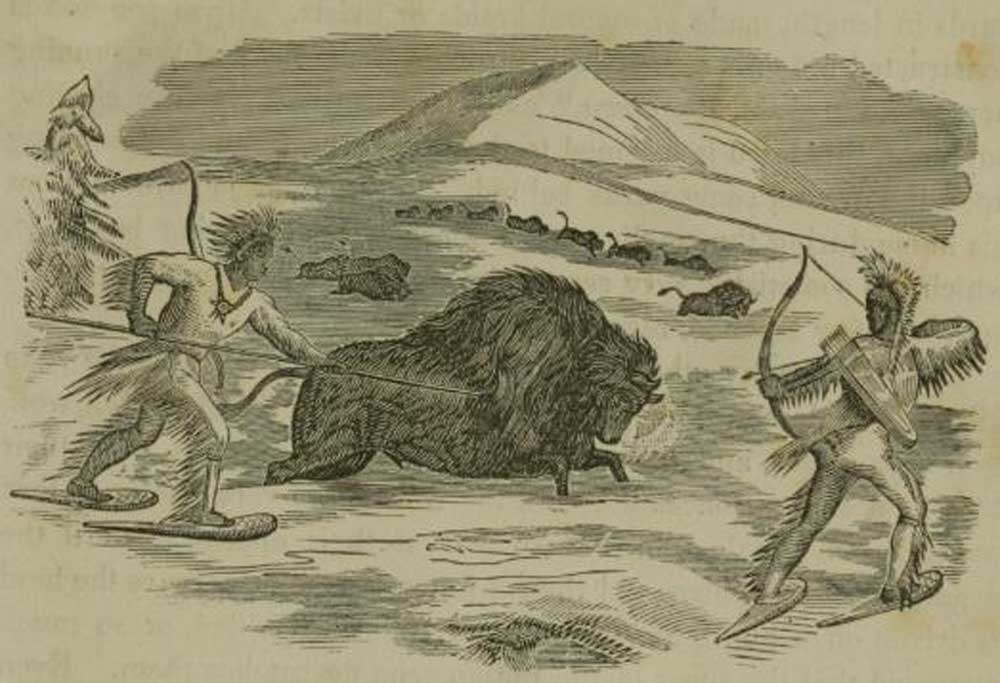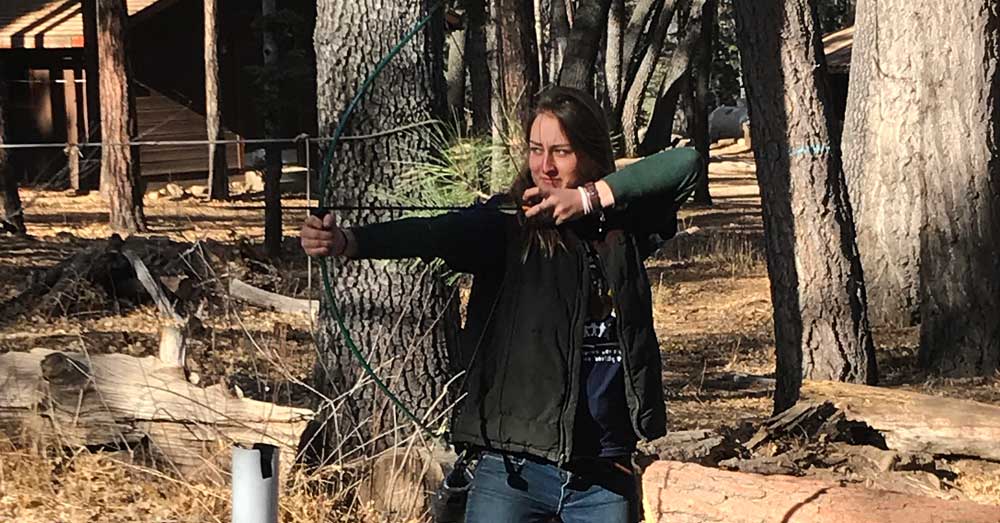 As staff members at High Trails, we are offered opportunities to visit other outdoor schools and exchange ideas with others in the outdoor field with hopes to deliver the best possible curriculum to the students that come to visit us. Recently, I took advantage of one of these opportunities and visited a site roughly two hours from High Trails. Over the course of the weekend I learned invaluable information on teaching techniques, group management, and new content to deliver during my classes, most of which I accepted at face value, apart from one fact.
As staff members at High Trails, we are offered opportunities to visit other outdoor schools and exchange ideas with others in the outdoor field with hopes to deliver the best possible curriculum to the students that come to visit us. Recently, I took advantage of one of these opportunities and visited a site roughly two hours from High Trails. Over the course of the weekend I learned invaluable information on teaching techniques, group management, and new content to deliver during my classes, most of which I accepted at face value, apart from one fact.
While exploring the site, a member of my group noticed a fact posted at the archery range that stated that archery was brought to North America in the 1600’s by European conquerors.
This statement immediately struck me as odd considering the years of education that engrained an image in my head of Native American warriors and hunters equipped with a bow and arrow. Not to mention the technological advancement that many ancient American cities are described to have displayed long before Europeans landed on the coast of the West Indies. It’s probable that the sign was referring to archery as a sport, as opposed to using a bow and arrow as a means for survival. However, as a history major, the initial shock brought on by reading the fact stirred a curiosity about the ancient origins of using a bow and arrow in North America and what historically made North American archery equipment unique to bows and arrows made in other parts of the world.
In the modern world, we often overlook the groundbreaking innovation that the bow and arrow was at the time of its inception. Imagine a scenario in which all of the technologies we have, including electricity and firearms, suddenly disappeared. Rather quickly, our grocery stores would run out of food, both perishable and non perishable, and we would be forced to forage and hunt for our food once again as our ancient ancestors had using a bow and an arrow. A lifestyle that the first people of the North American region had honed down to a science, but that would be very difficult for modern populations. The Yuhaviatum, the first people to populate the San Bernardino National Forest, needed bow and arrow technology for large game hunting. Without the accuracy and trajectory provided by archery equipment it likely would have been impossible to sustain their population.
Archery Equipment Across the World
Because archery equipment was historically made of perishable materials (i.e. wood, leather, and animal hair) archaeological records on the exact time and place that the bow and arrow was first developed are ambiguous, however the earliest specimens clearly defined as bows were recovered from Holmegaard, Denmark and date back to about 6,000 BC. With its inception theorized to have taken place in either African or European regions, the use of the bow and arrow spread across the world among historic peoples in Africa, Asia, and the Americas. 1 Archaeological records that have been recovered from surviving art and religious pieces found painted on the walls of caves and carved into fragments of tusk and bone suggest that the “archery complex” as we know it today equipped with the bow, string, arrow, fletching, arrowhead, and nock likely evolved in several areas independently, over an extended period of time. One of those areas was, without a shadow of historical doubt, the North American region. These archaeological records also determine that ancient peoples carried archery equipment from Asia to the Americas during their migration along the land bridge that once connected the two continents some twenty thousand years ago. 2

North American Bows
Once the technology made its way across the land bridge that once connected the east and the west, alterations surrounding the materials used and the methods developed around them to build bows and arrows became unique to North America. Across the continent harder woods were used for bow making, on the west coast in particular, Native American bow makers used yew, juniper, hickory, or ash to make “wide, flat bows, usually with a narrow handle.” Furthermore, the North American innovation of using animal sinew to reinforce wooden bows not only strengthened the bow itself, but also increased the elasticity of the weapon allowing arrows to be shot both further and more quickly. Modern bows achieve this same feature through the use of fiberglass, however our modern bow technology doesn’t match the trajectory of these more “primitive” bows. 3

North American Arrows
In North America, arrowheads and tools were commonly made from stone: flint, jasper, agate, petrified wood, chalcedony, and quartz. Quartz in particular was a popular material amongst the Native Americans along the West Coast. Rated on Moh’s scale of hardness ranging from talc, which is the softest with a rating of one, to diamond, which is rated a ten and is the hardest, quartz is a 7. 4 In order to make this hard stone more workable, early inhabitants of the Pacific Northwest used two different methods to treat stones before shaping them by knapping (striking them with other stones).
In some cases, ancient arrow makers would soak their material in water for an extended period of time during which water fills the spaces in between crystals thereby providing more pressure once the stone is struck. Otherwise heat treatment would be use to prepare stones for knapping. To do so early North American arrow makers dug a pit about eight inches deep, filled it with rocks, layered soil on top of the rocks, and used kindling and wood to start a fire over top of it. One theory holds that heat treating remakes crystals into a “more uniform, denser form” which allows for longer, more consistent flakes when struck that require less effort to make. 5

Quartz found on the ground here in the forest.
Knapping was generally a social task; Native American knappers often gathered around campfires, a communal and comfortable setting to complete their work. However, that should not suggest that knapping is not a honed skill that requires effort and practice. There is much more to the ancient skill of knapping than one may initially assume. There are three main techniques used for knapping, the hand-tool flaking process: percussion flaking, which uses a hammerstone to break off large chips to form the point of the arrowhead, pressure flaking, done by using an antler or other sharp tool to rough-shape the arrowhead, and indirect percussion flaking, usually involving a combination of the two tools, the hammerstone and the antler, to flake off small pieces to put the finishing touches on the weapons and to serrate edges if needed. Evidence of these techniques can be found on historical arrowheads found across North America that display a wavy texture created by the shock waves driven to the instruments when they were being formed. 6
Why It Matters
As outdoor educators know, archery is one of the classes that students look forward to most going into their week at outdoor science school. At High Trails, it is very important to us that we provide our students with an authentic and exciting experience outside. The more we know about the history of archery as a means for survival in the area that we are teaching, the more developed and interesting our classes can be. Ancient bows and arrows were made from the natural materials found all around us here at High Trails, especially quartz which can be found on any of the trails we take our students hiking on.
For experiential and visual learners, or for students that have never seen quartz before, being able to touch and hold the materials that were used to build the tools that were once needed for survival helps put them in the mindset of the first inhabitants of the San Bernardino National Forest. By taking advantage of every opportunity we can to get our class to interact responsibly with the world around them, we as instructors have a unique opportunity to offer students a different perspective on how our planet should be treated.

Hannah posing for a picture for this blog post…
At High Trails Outdoor Science School, we literally force our instructors to write about elementary outdoor education, teaching outside, learning outside, our dirty classroom (the forest…gosh), environmental science, outdoor science, and all other tree hugging student and kid loving things that keep us engaged, passionate, driven, loving our job, digging our life, and spreading the word to anyone whose attention we can hold for long enough to actually make it through reading this entire sentence. Whew…. www.dirtyclassroom.com
- Grayson, Charles E., Mary French, and Michael J. O’Brien. Traditional Archery from Six Continents: The
Charles E. Grayson Collection. Columbia: University of Missouri Press, 2007 ↩ - Sapp, Rick. The Ultimate Guide to Traditional Archery. Skyhorse Publishing, Inc, 2013 ↩
- Hamm, Jim. Bows & Arrows of the Native Americans. Globe Pequot Press, 1992 ↩
- Burch, Monte. Making Native American Hunting, Fighting, and Survival Tools, The Complete Guide to Making and Using Traditional Tools. Rowman and Littlefield, 2007 ↩
- Burch, Monte. Making Native American Hunting, Fighting, and Survival Tools, The Complete Guide to Making and Using Traditional Tools. Rowman and Littlefield, 2007 ↩
- Burch, Monte. Making Native American Hunting, Fighting, and Survival Tools, The Complete Guide to Making and Using Traditional Tools. Rowman and Littlefield, 2007 ↩

Comments are closed.